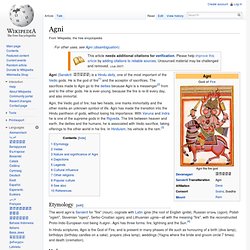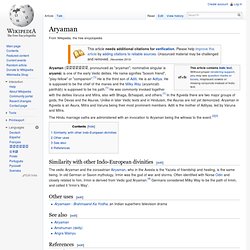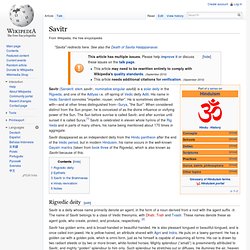

Agni. Agni (Sanskrit: अग्नि) is a Hindu deity, one of the most important of the Vedic gods.

He is the god of fire[1] and the acceptor of sacrifices. The sacrifices made to Agni go to the deities because Agni is a messenger[2] from and to the other gods. He is ever-young, because the fire is re-lit every day, and also immortal. Agni, the Vedic god of fire, has two heads, one marks immortality and the other marks an unknown symbol of life. Agni has made the transition into the Hindu pantheon of gods, without losing his importance. Etymology[edit] The word agni is Sanskrit for "fire" (noun), cognate with Latin ignis (the root of English ignite), Russian огонь (ogon), Polish "ogień", Slovenian "ogenj", Serbo-Croatian oganj, and Lithuanian ugnis—all with the meaning "fire", with the reconstructed Proto-Indo-European root being h₁égni-. Aryaman. Aryaman (अर्यमन्, pronounced as "aryaman"; nominative singular is aryamā) is one of the early Vedic deities.

His name signifies "bosom friend", "play-fellow" or "companion".[1] He is the third son of Aditi. He is an Aditya. He is supposed to be the chief of the manes and the Milky Way (aryamṇáḥ pánthāḥ) is supposed to be his path.[1] He was commonly invoked together with the deities Varuṇa and Mitra, also with Bhaga, Bṛhaspati, and others.[1] In the Ṛgveda there are two major groups of gods, the Devas and the Asuras.
Unlike in later Vedic texts and in Hinduism, the Asuras are not yet demonized. Aryaman in Ṛgveda is an Asura, Mitra and Varuna being their most prominent members. The Hindu marriage oaths are administered with an invocation to Aryaman being the witness to the event.[2][3] Similarity with other Indo-European divinities[edit] Mitra (Vedic) This article is about the Vedic deity Mitra.

For other divinities with similar names, see Mitra. Indic Mitra should not be confused with the Zoroastrian divinity Mithra (Miθra). Although their names both derive from the Proto-Indo-Iranian noun *mitra, "(that which) causes binding", a shared etymology through which the two also share some properties, Indic Mitra and Iranian Mithra developed differently, and the two figures are not identical. Indic Mitra should also not be confused with Roman Mithras. [note 1] Saranyu. Saraṇyū is the female form of the adjective saraṇyú, meaning "quick, fleet, nimble", used for rivers and wind in the Rigveda (compare also Sarayu).

Etymologically, Saranyu may be related to Helen. In Rigveda 10.17, Saranyu is the daughter of Tvastar, and, like Helen, is abducted, and Vivasvat is given a replacement bride instead. 1ab tváṣṭā duhitré vahatúṃ kṛṇotîtīdáṃ víśvam bhúvanaṃ sám eti1 1cd yamásya mātâ paryuhyámānā mahó jāyâ vívasvato nanāśa 2ab ápāgūhann amŕtām mártyebhyaḥ kṛtvî sávarṇām adadur vívasvate 2cd utâśvínāv abharad yát tád âsīd ájahād u dvâ mithunâ saraṇyûḥ Tvastar prepares the bridal of his Daughter: all the world hears the tidings and assembles.
But Yama's Mother, Spouse of great Vivasvat, vanished as she was carried to her dwelling. From mortal men they hid the Immortal Lady, made one like her and gave her to Vivasvat. Saranyu brought to him the Asvin brothers, and then deserted both twinned pairs of children. See also[edit] References[edit] Savitr. Savitr disappeared as an independent deity from the Hindu pantheon after the end of the Vedic period, but in modern Hinduism, his name occurs in the well-known Gayatri mantra (taken from book three of the Rigveda), which is also known as Savitri because of this.

Rigvedic deity[edit] Savitr is a deity whose name primarily denote an agent, in the form of a noun derived from a root with the agent suffix -tr. The name of Savitr belongs to a class of Vedic theonyms, with Dhatr, Tratr and Tvastr. These names denote these as agent gods, who create, protect, and produce, respectively. [2] Savitr has golden arms, and is broad-handed or beautiful-handed. Like Pushan and Surya, he is lord of that which moves and is stationary. In the Rig veda, there are two classes of deities whose nature is founded on abstraction.
In ‘The Religion and Philosophy of the Veda and Upanishads’ Vol. 1, noted Indologist A. Surya. Surya (Sanskrit: सूर्य Sūrya, "the Supreme Light"[2]) Suraya or Phra Athit is the chief solar deity in Hinduism.

The term Surya also refers to the Sun, in general. Surya as the Sun is worshipped at dawn by most Hindus and has many temples dedicated to him across India. He also enjoys worship as a part of the Navagraha. He is especially worshipped in the Hindu festivals of Ratha Saptami, Makar Sankranti, Chhath and Samba Dashami. Depictions[edit] Surya sculpture Surya is sometimes depicted with two hands holding a lotus in each hand. Arka form[edit] Surya is worshiped in various forms throughout India.
The grandest Surya temple is Konark Surya Temples built by Ganga Vamsi king Narasimha Dev of Orissa.